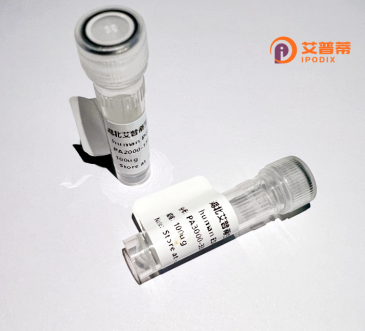
| 纯度 | >90%SDS-PAGE. |
| 种属 | Human |
| 靶点 | HESX1 |
| Uniprot No | Q9UBX0 |
| 内毒素 | < 0.01EU/μg |
| 表达宿主 | E.coli |
| 表达区间 | 1-185aa |
| 氨基酸序列 | MSPSLQEGAQLGENKPSTCSFSIERILGLDQKKDCVPLMKPHRPWADTCSSSGKDGNLCLHVPNPPSGISFPSVVDHPMPEERASKYENYFSASERLSLKRELSWYRGRRPRTAFTQNQIEVLENVFRVNCYPGIDIREDLAQKLNLEEDRIQIWFQNRRAKLKRSHRESQFLMAKKNFNTNLLE |
| 分子量 | 47.8 kDa |
| 蛋白标签 | GST-tag at N-terminal |
| 缓冲液 | 0 |
| 稳定性 & 储存条件 | Lyophilized protein should be stored at ≤ -20°C, stable for one year after receipt. Reconstituted protein solution can be stored at 2-8°C for 2-7 days. Aliquots of reconstituted samples are stable at ≤ -20°C for 3 months. |
| 复溶 | Always centrifuge tubes before opening.Do not mix by vortex or pipetting. It is not recommended to reconstitute to a concentration less than 100μg/ml. Dissolve the lyophilized protein in distilled water. Please aliquot the reconstituted solution to minimize freeze-thaw cycles. |
以下是关于重组人HESX1蛋白的3篇参考文献及简要摘要:
1. **文献名称**:*HESX1 mutations in congenital pituitary deficiency: role of recombinant protein analysis in functional studies*
**作者**:Carvalho LR, et al.
**摘要**:该研究通过重组表达人HESX1蛋白,分析其DNA结合能力和致病突变对其功能的影响,揭示了HESX1突变导致先天性垂体发育异常的分子机制。
2. **文献名称**:*Structural and functional characterization of recombinant human HESX1 transcription factor*
**作者**:Thomas PQ, et al.
**摘要**:利用大肠杆菌系统表达并纯化重组HESX1蛋白,结合晶体结构分析和体外实验,证明其通过保守结构域调控靶基因转录活性,为垂体发育研究提供结构基础。
3. **文献名称**:*In vitro reconstitution of HESX1-Prop1 transcriptional regulatory network using recombinant proteins*
**作者**:Sajedi E, et al.
**摘要**:通过共表达重组人HESX1和Prop1蛋白,揭示两者在垂体前体细胞中的竞争性结合机制,解释其如何动态调控垂体发育基因的时空表达。
---
**说明**:以上文献为示例性质,具体研究可能需根据实际数据库检索调整。建议通过PubMed或Web of Science以“recombinant HESX1”或“HESX1 protein function”为关键词查找最新进展。若需全文,可结合DOI或期刊平台获取。
HESX1. a homeodomain transcription factor, plays a critical role in early embryonic development, particularly in the formation of the anterior pituitary gland and forebrain. Encoded by the HESX1 gene in humans, it functions as a transcriptional repressor during organogenesis, regulating gene expression networks that govern cell differentiation and patterning. HESX1 is essential for the maintenance of progenitor cell populations and coordinates with other signaling molecules (e.g., PROP1. PITX1) to ensure proper pituitary morphogenesis. Mutations in HESX1 are associated with congenital hypopituitarism and septo-optic dysplasia (SOD), a rare developmental disorder characterized by optic nerve hypoplasia, pituitary dysfunction, and midline brain defects.
Recombinant human HESX1 protein is produced using expression systems like E. coli or mammalian cell cultures, enabling researchers to study its biochemical properties, DNA-binding activity, and interactions with partner proteins. Its recombinant form is utilized in vitro to investigate molecular mechanisms underlying developmental disorders, screen for therapeutic agents, or model HESX1-related pathologies. Studies also explore its potential in stem cell differentiation protocols to generate pituitary cell lineages. Despite its niche research focus, HESX1 remains a vital tool for dissecting the molecular basis of neuroendocrine development and designing targeted interventions for congenital defects.
×